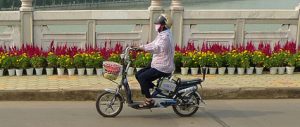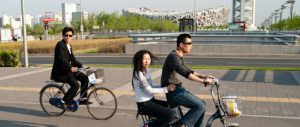Disruptive technologies are game changers that herald a new era, toppling established market leaders within a short span of time. The battery-operated electric two-wheeler, or electric bike, is one such technology. Within a little over a decade, it will have bridged the 125-year lead that internal combustion engine (ICE) two-wheelers running on petrol have had in the market.
The industry growth chart for the past decade tells this phenomenal growth story, scripted by China almost single-handedly.
In 1998, China commenced mass-producing electric bikes indigenously with 56,000 units made by a dozen producers. The world that year produced 42 million motorbikes, almost all fuelled by fossil fuels. By 2010, China had 2,000-odd manufacturers producing 30 million electric units a year to feed a rapidly-growing annual global market of US$12 billion.
Unlike other export-oriented industries, China consumes 80% of its own production. It has over 150 million electric bikes on the road, while Europe, with 18 million units, comes a distant second. India, with less than 500,000 vehicles produced, is low down on the list. Its big, global two-wheeler brands – Hero Motors, Bajaj Auto, Lohia Machines and TVS – have missed a trick.
In 2010, the world produced 60 million motorbikes that ran on fossil fuel and 32 million electric and hybrid two-wheelers. With a near average yearly growth of 20%, electric-powered units will close the gap by 2015, with both categories expected to be producing 70 million units individually by that time.
The world’s five largest motorcycle markets are China, India, Indonesia, Brazil and Vietnam, which together have three billion people in need of low-cost, eco-friendly vehicles for daily commutes. Other emerging economies will soon latch on to the China growth story. Also, it is only a matter of time before solar batteries replace lead-acid, lanthanum and lithium ion ones. “In China, electric bicycles have a moderating influence on the use of cars,” advocacy group The Clean Air Initiative for Asian Cities told The New York Times. As a result, there are five times more electric bikes on China’s roads than cars.
Most of these are low-powered units of 200 watts, fitted with reusable lead acid batteries. They typically cost 2,400 yuan (less than US$400), the average monthly pay of a Chinese worker. They are no-frills utility vehicles chugging steadily at 20 kilometres an hour. The workforce typically travels 50 kilometres a day on single charge, usually from home to workplace, and is said to save 150 million worker hours each day. By contrast, the US motorbike market is 82% for recreation with low average bike runs of 1,000 miles per year, against 12,000 miles per year driven by the American car user.
China’s policy initiatives started with its State High-Tech Development Plan, or 863 Programme, in 1986. China was still poor, but slowly changing from Mao-style communism to Deng-style market economics. Among the seven technology sector plans identified by physicist Wang Ganchang and his team of engineers, and endorsed by Deng Xiaoping, was the energy plan that included the 863 Electric Drive Fuel Cell Vehicle Project.
This was not rocket science. As China would progress into a global factory over the years, it would need to empower millions of workers with personal transport for commuting to work. To avoid the risk of becoming dependent on imported fossil fuel, China would have to develop a low-cost alternative energy solution for its commuters.
The electric bike would give China several key advantages. One, it would provide freedom from imported technology or resources. Two, it would be a measured scale-up of the bicycle that was already in use by the factory and farm workers. Three, China could obviate huge investments in mass-transport systems that depend on subsidies to remain operational. And last, but not least, the electric two-wheeler solution was cheap, efficient and sustainable.
China introduced several policy initiatives. During the 1980s and 1990s, it started using its pool of surplus labour to build cycle lanes parallel to roads throughout its cities. Today, all cities, even tier four and tier six towns with only one million people, have segregated bicycle tracks.
At the turn of the century, as China became more prosperous, it invested 800 million yuan (US$127 million) in the 863 fuel cell project. It created several common services facilities that small entrepreneurs could use to access technology and finance. As the component and accessory plants developed, so did the assemblers retrofitting traditional bikes with motors powered by lead acid-batteries. Intensive development of the battery industry, lead acid and lithium ion, also started. Over the next decade, a slew of subsidies and policy measures – subsidised land and monetary grants – propped up the industry. Consumers got cash incentives.
The subsidy was hiked repeatedly when new and powerful models were introduced and was upgraded last year to a maximum of 3,000 yuan (US$475) for a 1,000-watt two-wheeler costing up to 10,000 yuan (US$1,600). There was no need for registration of the electric two-wheelers and no licence requirement for the buyers. This made it popular and user-friendly for students, women and the aged because it was a low-cost, low-speed but power-assisted vehicle. The big boost to the industry came, however, when several cities started to ban conventional motorbikes. Though criticised as an extreme step, it ensured that every manufacturer moved into the production of electric vehicles in China.
China also invested heavily on the back-end components and is the world’s leading producer of electric controllers, DC motors, miniature circuit breakers, brushless motors, batteries and chargers. Its sovereign fund, China Investment Corporation, made sizable investments in lithium mining and processing units in China, Chile, Argentina and Australia, and controls 70% of the global supply.
In 2007, it introduced two-wheelers powered by lithium ion batteries that gave a higher speed as well as longer life. A new product category of electric scooters rapidly became popular that catered to the more sophisticated user by offering a higher speed of 50 kilometres-per-hour and longer charge life of 80 to 100 kilometres. As speeds rose, so did the number of accidents. Some municipalities like Shenzhen have responded by banning electric bikes for six months with the intent to introduce registration and licensing for higher-powered models.
Meanwhile, the advent of high-speed units and a hybrid version powered by lithium and lanthanum batteries have also spurred the interest of global majors. Yamaha, Honda, Suzuki, Peugeot, BMW and Volkswagen are all readying new models that will hit the market this year. At Delhi’s Auto Expo 2012, Indian manufacturers Hero Electricals, Lohia Auto and TVS Motor also displayed both electric-driven as well as hybrid versions.
However, the huge subsidy support and scalable volumes of China may make it difficult for Indian producers to match the success over the border. Considering that there is no supporting infrastructure – no bike lanes throughout the nation – the future and growth of the Indian market looks less certain than in China, unless the government becomes proactive.
China expects to produce 75 million units per year by 2020, with 500 million electric bikes on road. This will mean that a third of China’s population will be empowered with personal transport and will not need state-funded subsidised mass transport. The electric two-wheeler may prove a major trump card for China’s working class, providing access to low-cost, eco-friendly personal transport for commuting to work at China’s global factories.
Sandip Sen is an author, journalist and consultant. You can follow him on Twitter @ecothrust and read his risk management blog on The Economic Times here.
This article was first published in The Economic Times on February 9. It is reproduced here with permission.
This article is published as part of our Green Growth project, a collaboration between chinadialogue and The Energy Foundation.
Homepage image by Sam Sherratt; thumbnail by Ethnocentrics


